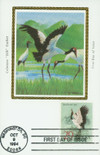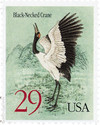
# 2867 - 1994 29c Black-necked Crane
U.S. #2867
1994 29¢ Black-Necked Crane
Cranes
- First US joint issue with China
- America’s 36th joint issue overall
Stamp Category: Commemorative
Set: Cranes
Value: 29¢, rate for first-class mail
First Day of Issue: October 9, 1994
First Day Cities: Washington, DC and Beijing, China
Quantity Issued: 77,748,000
Printed by: Banknote Corporation of America
Printing Method: Lithographed and Engraved
Format: Panes of 20 in plates of 120
Perforations: 10.9 x 11.1
Joint Issue: China #2528-29
Why the stamp was issued: To mark World Post Day with the first US-China joint issue.
About the stamp design: Both the US and China stamps featured the same crane artwork by Chinese artist Zhan Gengxi, with layout and typography done by US designer Clarence Lee. The US whooping crane was pictured on a yellow background and the Chinese black-necked crane on a green background with a mountain in the distance.
First Day City: The US and China stamps were issued in special joint-issue ceremonies on October 9, 1994, in Washington, DC, and Beijing, China. Both first day ceremonies included representatives from both nations. The American ceremony was held at the National Postal Museum.
Unusual fact about this stamp: There has been at least one pane discovered that was missing the red and black intaglio typography.
About the Crane Se-Tenant: The Chinese collaboration began back in 1990, when a Chinese postal delegation visited Washington, DC. The following year, two USPS officials traveled to China for a weeklong visit in which they discussed a variety of topics, including a joint issue.
USPS officials visited China two more times to discuss the project. In 1991, they decided that the stamps would focus on wildlife, to prevent any political or controversial objections. The representatives then narrowed the topic further to endangered species and flowers. At one point, they considered American eagles and Chinese pandas or tigers. However, both nations were already planning panda stamps. Additionally, the eagle is a bird of prey and the tiger a representation of kingship. They wanted something to symbolize peace and friendship and ultimately settled on cranes. The stamps would picture cranes from both countries – the North American whooping crane and the Chinese black-necked crane.
Both nations further agreed to issue two stamps, rather than picturing both cranes together, which wouldn’t naturally happen in nature. The China stamps were issued with two different denominations in separate panes, while the US stamps had the same denomination and were issued as an attached se-tenant.
History the stamp represents: There are 15 species of cranes worldwide, but only two are native to North America – the whooping crane and the sandhill crane. The tallest bird in North America, the whooping crane stands up to 5 feet tall and has a wingspan that measures between 7 and 8 feet. Also known as whoopers, their loud resonant call can be heard up to two miles away.
Native to the northern United States, whooping cranes migrate south during the winter. In the spring, they return north to their nesting grounds where they build their nests in the shallow water of a marsh or swamp. Together, male and female cranes share the task of raising the young.
Flocks of whooping cranes once nested on the open prairies of the US and Canada; however, as encroaching settlers disturbed their nesting grounds, the birds began to die out. By 1954 only one flock of 21 birds remained. Today laws protect the whooping crane and its habitat. Having been successfully bred in captivity it is once again beginning to thrive in the wild. But although there are currently more than 500 whooping cranes living in the wild, they still remain one of the rarest birds on the North American continent.
Cranes are wetland birds with long legs and necks. Fifteen species live in nearly every part of the world – only South America and Antarctica do not have any cranes. China has eight different species, six of which are endangered. The black-necked crane is one of the most endangered species, with only about 10,000 surviving.
U.S. #2867
1994 29¢ Black-Necked Crane
Cranes
- First US joint issue with China
- America’s 36th joint issue overall
Stamp Category: Commemorative
Set: Cranes
Value: 29¢, rate for first-class mail
First Day of Issue: October 9, 1994
First Day Cities: Washington, DC and Beijing, China
Quantity Issued: 77,748,000
Printed by: Banknote Corporation of America
Printing Method: Lithographed and Engraved
Format: Panes of 20 in plates of 120
Perforations: 10.9 x 11.1
Joint Issue: China #2528-29
Why the stamp was issued: To mark World Post Day with the first US-China joint issue.
About the stamp design: Both the US and China stamps featured the same crane artwork by Chinese artist Zhan Gengxi, with layout and typography done by US designer Clarence Lee. The US whooping crane was pictured on a yellow background and the Chinese black-necked crane on a green background with a mountain in the distance.
First Day City: The US and China stamps were issued in special joint-issue ceremonies on October 9, 1994, in Washington, DC, and Beijing, China. Both first day ceremonies included representatives from both nations. The American ceremony was held at the National Postal Museum.
Unusual fact about this stamp: There has been at least one pane discovered that was missing the red and black intaglio typography.
About the Crane Se-Tenant: The Chinese collaboration began back in 1990, when a Chinese postal delegation visited Washington, DC. The following year, two USPS officials traveled to China for a weeklong visit in which they discussed a variety of topics, including a joint issue.
USPS officials visited China two more times to discuss the project. In 1991, they decided that the stamps would focus on wildlife, to prevent any political or controversial objections. The representatives then narrowed the topic further to endangered species and flowers. At one point, they considered American eagles and Chinese pandas or tigers. However, both nations were already planning panda stamps. Additionally, the eagle is a bird of prey and the tiger a representation of kingship. They wanted something to symbolize peace and friendship and ultimately settled on cranes. The stamps would picture cranes from both countries – the North American whooping crane and the Chinese black-necked crane.
Both nations further agreed to issue two stamps, rather than picturing both cranes together, which wouldn’t naturally happen in nature. The China stamps were issued with two different denominations in separate panes, while the US stamps had the same denomination and were issued as an attached se-tenant.
History the stamp represents: There are 15 species of cranes worldwide, but only two are native to North America – the whooping crane and the sandhill crane. The tallest bird in North America, the whooping crane stands up to 5 feet tall and has a wingspan that measures between 7 and 8 feet. Also known as whoopers, their loud resonant call can be heard up to two miles away.
Native to the northern United States, whooping cranes migrate south during the winter. In the spring, they return north to their nesting grounds where they build their nests in the shallow water of a marsh or swamp. Together, male and female cranes share the task of raising the young.
Flocks of whooping cranes once nested on the open prairies of the US and Canada; however, as encroaching settlers disturbed their nesting grounds, the birds began to die out. By 1954 only one flock of 21 birds remained. Today laws protect the whooping crane and its habitat. Having been successfully bred in captivity it is once again beginning to thrive in the wild. But although there are currently more than 500 whooping cranes living in the wild, they still remain one of the rarest birds on the North American continent.
Cranes are wetland birds with long legs and necks. Fifteen species live in nearly every part of the world – only South America and Antarctica do not have any cranes. China has eight different species, six of which are endangered. The black-necked crane is one of the most endangered species, with only about 10,000 surviving.











